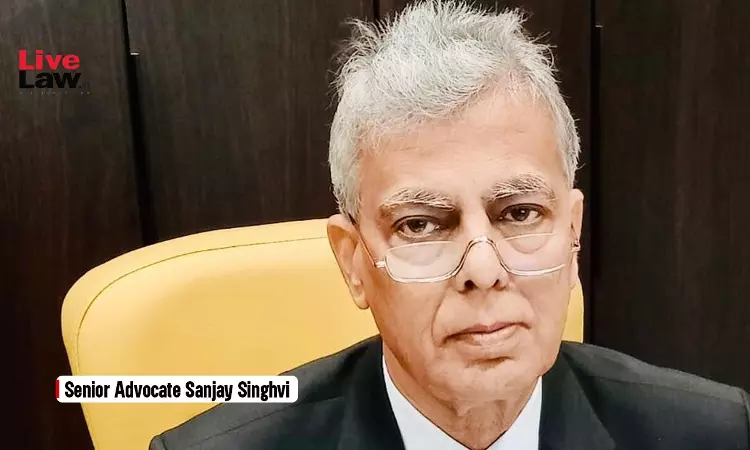Senior Advocate Sanjay Singhvi: A Life Of Commitment Combined With Determination And Compassion
Friends of Shri Sanjay Singhvi
1 May 2025 12:42 PM IST

Sanjay Singhvi was an indefatigable foe of injustice: right from the stirrings of youth to his wrenchingly early death at the age of 66. In different phases of his life, Sanjay immersed himself in an astonishing range of commitments: student activism, the fight against caste atrocities, the struggles of slum-dwellers and workers and the cause of communal harmony. These were all deep engagements in Sanjay's pursuit of justice and bore shining testimony to his unflinching egalitarian commitment.
Born in Mumbai on 15 May 1958 to well-known and progressive lawyer-parents, the late Sr. Adv. K K Singhvi and Pushpa Singhvi, Sanjay had a brilliant scholastic journey starting from St Xavier's School (where boxing was his passion). Then St Xavier's College (where mathematics was his first love) from where he graduated in Bsc in 1978. Finally, to Government Law College (where debate was his lode-star), from where he completed his LLB in 1981. He was granted his sanad from the Bar Council of Maharashtra & Goa on 6th August 1982.
When the Emergency was imposed in June 1975, student activities were curbed and Sanjay was involved in the pro-democracy initiatives outside the college. Even after the Emergency was lifted in March 1977, the management of St Xavier's College refused to withdraw its oppressive Emergency-era rules and soon a group called the 'Xaverian Union' was born. The agitation in St Xavier's in 1977-78 attracted lavish attention in Mumbai's newspapers. It culminated in a 10-day hunger strike by Sanjay and Rabindra Hazari, who camped in the driveway of the college. Apart from hundreds of students from various colleges throughout Mumbai, they were visited each evening by their fathers - KK Singhvi coming from the High Court and R.K.Hazari coming from his office, being then the Dy. Governor of RBI. Ultimately, the offending rules were withdrawn.
The college management, however, denied readmission to Rabindra Hazari and several other student activists. The rebuffed students took the management to court. Sr Advocate Indira Jaising fought and won their case. Having already passed out of college with a BSc. in Mathematics, Sanjay could not be denied re-admission. But, as a newly-enrolled law student at Government Law College, he actively helped with the case.
Sanjay was also a student leader in Bombay University. He played a leading role in forming the 'Student Anti-Fee-Rise Action Committee' (SAFAC) in 1978, to oppose an unjustified fee hike. The agitation was successful and the fee hike was quickly cancelled.
But he wasn't done with St Xavier's College. He and his colleagues later took up the battle for fair wages and working conditions for the college canteen workers. After a prolonged struggle, the workers triumphed. In between, circa 1980, Sanjay also spent a year as roving reporter at R K Karanjia's unpredictable tabloid, “Blitz”.
Sanjay's father, the late Sr. Advocate K K Singhvi, was the Standing Counsel for the Bombay Municipal Corporation when the Olga Tellis pavement-dweller case was filed in the Bombay High Court. Since Sanjay was fighting shoulder-to-shoulder with the affected slum and pavement-dwellers, he pleaded with his father to refuse to appear in this matter. Sr. Adv. K K Singhvi refused. Promptly, Sanjay packed his bag and moved out of his parental home to live in a sparse hut in a Dalit slum in Wadala called Ramamatawadi (named after Dr B R Ambedkar's first wife, Rama). He lived there for several months while the case continued. Sanjay is fondly remembered in Ramamatawadi to this day.
Accompanied by Dalit thinker and bard Sambhaji Bhagat, Sanjay also toured the Marathwada region to get a first-hand account of the atrocities committed on dalits during the Namantar struggle.
It must be mentioned here that in 1987 Sanjay's trade union work in the Wagle Estate area of Thane and in the Bhiwandi powerloom sector drew the ire of the local police, one of whom brutally beat, roped and paraded him. This caused an uproar in the public as well as at the Bar. Both the WIAA and BBA passed resolutions condemning the assault and declared a one-day strike. The Labour Law Practitioners Associations also followed suit.
Among the few senior lawyers who headed a chamber exclusively espousing the cause of workers - juniors, interns and other employees were all treated as equals. All sat around the conference table at lunchtime, where Sanjay made every lunch break an interactive session filled with lively debate not only on on-going court matters, but current affairs, politics, science, philosophy… - and the contents of everyone's tiffin box.
Sanjay's belief in empowering individuals extended to his mentorship of juniors. He valued autonomy and trusted those under his guidance to take initiative and grow through firsthand experiences. When he allowed them to work independently as junior advocates, it wasn't merely a gesture of trust but a deliberate act to nurture confidence and competence. This approach not only enhanced their skills but also instilled a deep sense of responsibility, illustrating his dedication to fostering growth through empowerment. Working with Sanjay allowed them to come into their own. He constantly urged them to think for themselves and question received knowledge and opinion, enabling them to create their own spaces for independent thinking and reflection.
Sanjay, who was designated a Senior Counsel by the Bombay High Court on 20.09.2014, always emphasized the compassionate principle that no client should be turned away merely because she or he could not pay the fees.
The cause of unorganised workers was dearest to him and challenging the contract labour system was probably the most important area of his legal career. His success in a number of cases lifted the workers from poverty and gave dignity. Hindustan Unilever Ltd v. Contract Laghu Udyog Kamgar Union (2009 SCC OnLine Bom
2457) was a case of a sham & bogus contractual system with a chequered history over 30 years from the Industrial Court up to the Supreme Court, followed by remand to the Industrial Court and back to the High Court. The purported contract labour become the permanent employees of the Company. This transformed the lives of the workmen who started work at the multinational for around Rs12/- per day. The gardeners who in their navvaris could not afford footwear could now see for the first time gold bangles and arrears, giving them dignity when they went to their rural homes and lifted them from their poverty.
In Municipal Corporation of Gr. Mumbai v. Kachara Vahatuk Shramik Sangh ((2017) 1 CLR 798) he successfully defended the Industrial Tribunal Award declaring around 2700 safai kamgars cleaning the streets of Mumbai to be the permanent & direct employees of the BMC and not of the so called contractors. He then successfully defended this Judgment of the High Court before the Supreme Court. This case required navigating the tests of employer-employee relationship along with questions of creation of posts and the precedent of Umadevi. The Bombay High Court held that the Umadevi Judgement cannot become a license for exploitation and case of the workers was sui generis and cannot be compared to any other contract labour dispute. In a follow up matter around another 580 were made permanent and the High Court Order was recently sustained in the Supreme Court.
Sanjay appeared in matters like that of the Bajaj workers (Sunil Prahlad Khomane & Ors. V. Bajaj Auto Ltd. (2021 SCC OnLine Bom 129) where temporary workers were denied permanency and its benefits by being given artificial breaks in service.
The matters concerning unorganised workers in Sanjay's view had the odds stacked against them and it was in these matters that his analytical and logical skills coupled with his motivation for an egalitarian society were at their sharpest.
In Gujarat Mazdoor Sabha v. The State of Gujarat (2020) 10 SCC 459, a Writ Petition filed directly before the Supreme Court under Article 32, Sanjay successfully took up a challenge to a notification, issued during the Covid-19 pandemic, by which the State of Gujarat exempted factories from observing a range of obligations under the Factories Act, including payment of overtime wages. While drawing on a range of principles in statutory interpretation, constitutional and labour law, his arguments were keenly foregrounded in the working-class struggle leading up to the Factories Act, the constitutional mandate to provide just and humane working conditions and protect against forced labour. The notification was ultimately held by the Hon'ble Supreme Court to be an “affront to workers' right to life and rights against forced labour that are secured by Articles 21 and 23 of the Constitution” and, accordingly, quashed.
Another of his landmark cases was where he appeared for the mill workers as intervenors in the case of Bombay Dyeing and Manufacturing Co. Ltd v. The Monitoring Ctte ((2012) 114(40 Bom LR 2025). In this case, the Division Bench of the Bombay High Court, while interpreting the amended Development Control Regulation (DCR) 58, held that once a redevelopment layout is approved, the mill
owner must immediately hand over the lands earmarked for MHADA (for public/mill workers' housing) and not wait until the physical construction had been completed. Allowing the intervention application filed by the workers and their union, the Court directed Bombay Dyeing to immediately transfer 26,556.30 sq.m. from Spring Mills, Wadala, and 5,770.52 sq.m. from Bombay Dyeing Textile Mill, Lower Parel to MHADA. The Court emphasized that the handover must occur promptly after layout approval, thereby safeguarding the housing rights of mill workers and ensuring that redevelopment cannot be used to defeat their rightful entitlements.
In 2013 Sanjay forayed into Company law on behalf of the workmen of Swadeshi Mill. (Forbes & Company Ltd. & Anr versus Official Liquidator & Anr (Appeal No. 34/12 dt. 23.08.13). This case laid down important principles for the interpretation of section
466 of the Companies Act, 1956, and the granting of stay on the winding up of company & its revival. Sanjay successfully argued that the concept of commercial morality that guides the application of this section necessitates an intention to resume business operations, rather than merely maintaining the shell of a corporate existence by converting the objects of the company to real estate development.
The pensionary benefits of the employees in Hindustan Petroleum were unilaterally taken away by the Company despite having been in force for around 25 years. The pensioners, represented by Sanjay, were able to have the offending notifications struck down before the Division Bench of the Bombay High Court (Pensioners Social And Welfare Association - Vs Hindustan Petroleum Corporation Limited & Ors- 2019 SCCOnline Bom 750 / (2019) 4 AIR BOM). The matter was halfway through in the Supreme Court when Sanjay was struck with resurgent cancer, but Sr. Advocate C.U.Singh helped take the workers to the finishing line (as he did in so many matters where cancer prevented Sanjay from appearing). The Company's Petition came to be dismissed.
Sanjay had also earlier put up a sustained and successful fight in the Bombay High Court and Supreme Court to protect an Award of the Industrial Tribunal granting a pension to employees in Hindustan Unilever's Research Centre (Hindustan Unilever Ltd. V. Hindustan Lever Research Centre Employees' Union & Anr WP. No. 1316/20 dt. 14.10.2014), giving succour to workmen in the twilight of their lives.
He succeeded in establishing that field workers repairing lifts in the city were part of the controlling establishment and part of an undertaking of Otis Elevators thereby giving the workmen the right to have a statutorily recognised union in the establishment (Order dated 09.10.2014 of the Bombay High Court in Bhartiya Kamgar Sena vs. OTIS Elevator Employees Union: Original Side Writ Petition No. 1293 of 2012).
Most mortals would have been satisfied with such accomplishments alone—but not the multi-faceted Sanjay! He had an abiding interest in history and literature and had taught himself Urdu in order to directly engage with his favourite poets, Sahir and Faiz. He also knew more than a thing-or-two about architecture and the arts & would often
delight and surprise colleagues once Supreme Court hearings were over with insights and information regarding the architectural monuments in and around Delhi. An avid techie, but even there irreverent to the establishment: it was never 'Windows', always 'Linux'; not 'IPad” but 'Samsung'…
Sanjay was also troubled by certain questions of Indian history and geography, which prompted him to undertake to write –after detailed study - an extended essay ( in two parts ) on the subject in June 2024. Unfortunately, he never got around to writing Part II of this essay.
Forever a believer in mens sana in corpore sane, Sanjay was a dedicated cyclist. He would often cycle early morning, even after the initial cancer diagnosis, from Mahim to Nariman Point and back before leaving for office. He was also an active mountaineer since his college days, haring off for treks and rock climbing on weekends. As part of a group of Bombay University mountaineers, he and his fellow climbers discovered and developed rock climbing-routes in the very heart of South Mumbai, i.e. at Malabar Hill. He was also a member of a Bombay University expedition to the Himalayas, in 1977. At a high-altitude camp, one of the members - his close friend Ashwin - had a major & life-threatening infection in his leg, and was unable to walk. Sanjay carried his team-mate on his back all the way down to the base camp in a few hours. If not for Sanjay, his mate may have lost a limb.
In recent years, Sanjay loved nothing better than going for a never-ending walk or cycling in some sylvan surroundings with long-time buddy and fellow-climber, Ashwin Tombat. His last such foray was in the environs of Pembrokeshire (Wales) in 2024.
For those who knew Sanjay well enough, the idea of defeat was alien to him: he was always brimming with ideas and child-like enthusiasm. For the last couple of years, he grappled with the possibility of setting up an alternative think-tank as well as establishing a pro-people media network. But then his ailment blindsided him and brutally cut short a life full of commitment combined with determination, compassion & fun.
It was for him perhaps that the poet said:
“Kinare se hi tufaan ka tamasha dekhnewale Kinare se kabhi andaaza-e-tufaan nahi hota”
Sanjay Singhvi is survived by his wife and life partner, Advocate Jane Cox, and his younger brother, Nitin.


